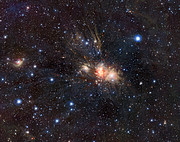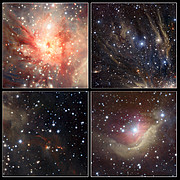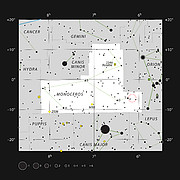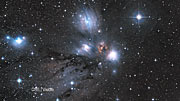Persbericht
VISTA onthult het geheim van de Eenhoorn
6 oktober 2010

Acknowledgment: Cambridge Astronomical Survey Unit)
Een nieuwe opname van ESO’s surveytelescoop VISTA toont een uitzonderlijk landschap van gloeiende gasslierten, donkere wolken en jonge sterren in het sterrenbeeld Monoceros (Eenhoorn). Dit stervormingsgebied, dat bekendstaat als Monoceros R2, is ingebed in een enorme donkere wolk. In zichtbaar licht wordt dit gebied door interstellair stof vrijwel geheel aan het zicht onttrokken, maar in het infrarood is het een spectaculaire verschijning.
In het sterrenbeeld Eenhoorn ligt, verborgen in een reusachtige donkere wolk van moleculen en stof, een actief stervormingsgebied. Hoewel het aan de hemel niet ver van de bekendere Orionnevel lijkt te staan, is het met een afstand van ongeveer 2700 lichtjaar in werkelijkheid bijna twee keer zo ver van ons verwijderd. In zichtbaar licht is te zien hoe het verstrooide licht van een aantal zware, hete sterren delen van de moleculaire wolk in een prachtige verzameling van reflectienevels heeft veranderd. Maar de meeste van de jonge, zware sterren in dit gebied gaan schuil achter dicht interstellair stof dat vrijwel al hun ultraviolette en zichtbare straling absorbeert.
Op deze fraaie infraroodopname, gemaakt met de Visible and Infrared Survey Telescope for Astronomy (VISTA [1], eso0949) van de ESO-sterrenwacht op de berg Paranal in het noorden van Chili, kijken we dwars door dit donkere gordijn van kosmisch stof heen. Hierdoor hebben we goed zicht op de plooien, lussen en filamenten die de intense deeltjeswinden en straling van hete, jonge sterren uit de stoffige interstellaire materie hebben gemodelleerd.
‘Toen ik deze opname voor het eerst zag, zei ik alleen maar “Wauw!”. Ik was verbaasd dat alle stofbanen rond de Monoceros R2-sterrenhoop en de “jets” van diep ingebedde, jonge stellaire objecten zo duidelijk te zien waren. Er zit zó’n grote schat aan details in deze VISTA-opnamen’, zegt Jim Emerson van de Queen Mary Universiteit van Londen en leider van het VISTA-consortium.
Met zijn enorme beeldveld, grote spiegel en gevoelige camera is VISTA ideaal voor het maken van diepe, detailrijke infraroodopnamen van grote stukken hemel, zoals het Monoceros R2-gebied. De breedte van het beeldveld van VISTA komt op die afstand overeen met ongeveer tachtig lichtjaar. Aangezien het stof grotendeels transparant is op deze golflengten, komen veel jonge sterren die op opnamen in zichtbaar licht verborgen blijven in het infrarood tevoorschijn. De zwaarste van deze sterren zijn minder dan tien miljoen jaar oud.
De afbeelding is opgebouwd uit opnamen die in drie verschillende delen van het nabij-infrarode spectrum zijn gemaakt. In moleculaire wolken zoals Monoceros R2 maken de lage temperaturen en relatief hoge dichtheden de vorming van moleculen, waaronder die van waterstof, mogelijk. Onder bepaalde omstandigheden zenden deze moleculen veel nabij-infrarode straling uit. Veel van de roze en rode structuren op deze VISTA-opname worden waarschijnlijk gevormd door gasstromen van jonge sterren die deze gloed van moleculaire waterstof uitzenden.
Monoceros R2 heeft een compacte kern – niet groter dan twee lichtjaar – waar zeer zware, jonge sterren opeengepakt zitten. Ook bevindt zich hier een verzameling van heldere infraroodbronnen: dat zijn veelal pasgeboren zware sterren die nog door een stofschijf omgeven zijn. Dit gebied staat in het midden van de foto, waar bij nadere inspectie een veel hogere concentratie van sterren te zien is. De opvallend roodachtige structuren ter plaatse zijn kenmerkend voor de straling van moleculaire waterstof.
De meest rechtse van de heldere wolken in het midden van de foto is NGC 2170, de helderste reflectienevel in dit gebied. In zichtbaar licht vertonen zulke nevels zich als helderblauwe eilanden in een donkere oceaan, terwijl in het infrarood de op volle toeren draaiende fabrieken in hun inwendige te zien zijn, die honderden zware sterren produceren. NGC 2170 is al met een kleine telescoop vaag waarneembaar en werd in 1784 vanuit Engeland ontdekt door William Herschel.
De vorming van een ster duurt doorgaans een paar miljoen jaar. Het proces speelt zich af in wolken van interstellair gas en stof die honderden lichtjaren groot zijn. Omdat het interstellaire stof zichtbaar licht tegenhoudt, zijn waarnemingen op infrarode en radiogolflengten cruciaal voor het onderzoek van de beginstadia van de evolutie van sterren. Door de zuidelijke hemel systematisch in kaart te brengen, verschaft VISTA een enorme hoeveelheid gegevens, ruwweg 300 gigabyte per nacht, over gebieden die later in meer detail zullen worden bestudeerd met de Very Large Telescope (VLT), de Atacama Large Millimeter/submillimeter Array (ALMA) en de toekomstige European Extremely Large Telescope (E-ELT).
Noten
[1] Met zijn hoofdspiegel van 4,1 meter is de VISTA de grootste surveytelescoop ter wereld. Hij is bovendien uitgerust met de grootste infraroodcamera van alle telescopen (67 megapixel). VISTA is speciaal gemaakt voor het uitvoeren van hemelkarteringen, die begin 2010 van start zijn gegaan. De telescoop staat op een bergtop naast de Cerro Paranal, de thuisbasis van ESO’s Very Large Telescoop in het noorden van Chili. VISTA profiteert dus van dezelfde buitengewoon goed waarnemingsomstandigheden in dit deel van de Atacama-woestijn – een van de droogste gebieden op aarde. De slechts twintig kilometer verderop gelegen Cerro Paranal is onlangs geselecteerd als locatie voor de toekomstige European Extremely Large Telescope.
Meer informatie
ESO, de Europese Zuidelijke Sterrenwacht, is de belangrijkste intergouvernementele sterrenkundeorganisatie in Europa, en het meest productieve astronomische observatorium ter wereld. ESO wordt ondersteund door 14 landen: België, Denemarken, Duitsland, Finland, Frankrijk, Italië, Nederland, Oostenrijk, Portugal, Spanje, Tsjechië, het Verenigd Koninkrijk, Zweden en Zwitserland. ESO voert een ambitieus programma uit, gericht op het ontwerp, de bouw en het beheer van krachtige grondobservatoria die astronomen in staat stellen om belangrijke wetenschappelijke ontdekkingen te doen. ESO speelt ook een leidende rol bij het bevorderen en organiseren van samenwerking op sterrenkundig gebied. ESO beheert drie waarnemingslocaties van wereldklasse in Chili: La Silla, Paranal en Chajnantor. Op Paranal staat ESO’s Very Large Telescope (VLT), de meest geavanceerde optische sterrenwacht ter wereld. Ook is ESO de Europese partner van de revolutionaire telescoop ALMA. Daarnaast is ESO momenteel bezig met ontwerpstudies voor de 42-meter Europese Extremely Large optische/nabij-infrarood Telescoop (E-ELT), die ‘het grootste oog op de hemel’ ter wereld zal worden.
Links
Contact
Richard Hook
ESO, Paranal, La Silla, E-ELT and Survey Telescopes Public Information Officer
Garching bei München, Germany
Tel: +49 89 3200 6655
E-mail: rhook@eso.org
Marieke Baan (Perscontact Nederland)
ESO Science Outreach Network
en NOVA Informatie Centrum
Tel: +31(0)20-5257480
E-mail: eson-netherlands@eso.org
Over dit bericht
| Persberichten nr.: | eso1039nl |
| Naam: | Monoceros R2 |
| Type: | Milky Way : Nebula : Type : Star Formation |
| Facility: | Visible and Infrared Survey Telescope for Astronomy |
| Instruments: | VIRCAM |
Our use of Cookies
We use cookies that are essential for accessing our websites and using our services. We also use cookies to analyse, measure and improve our websites’ performance, to enable content sharing via social media and to display media content hosted on third-party platforms.
ESO Cookies Policy
The European Organisation for Astronomical Research in the Southern Hemisphere (ESO) is the pre-eminent intergovernmental science and technology organisation in astronomy. It carries out an ambitious programme focused on the design, construction and operation of powerful ground-based observing facilities for astronomy.
This Cookies Policy is intended to provide clarity by outlining the cookies used on the ESO public websites, their functions, the options you have for controlling them, and the ways you can contact us for additional details.
What are cookies?
Cookies are small pieces of data stored on your device by websites you visit. They serve various purposes, such as remembering login credentials and preferences and enhance your browsing experience.
Categories of cookies we use
Essential cookies (always active): These cookies are strictly necessary for the proper functioning of our website. Without these cookies, the website cannot operate correctly, and certain services, such as logging in or accessing secure areas, may not be available; because they are essential for the website’s operation, they cannot be disabled.
Functional Cookies: These cookies enhance your browsing experience by enabling additional features and personalization, such as remembering your preferences and settings. While not strictly necessary for the website to function, they improve usability and convenience; these cookies are only placed if you provide your consent.
Analytics cookies: These cookies collect information about how visitors interact with our website, such as which pages are visited most often and how users navigate the site. This data helps us improve website performance, optimize content, and enhance the user experience; these cookies are only placed if you provide your consent. We use the following analytics cookies.
Matomo Cookies:
This website uses Matomo (formerly Piwik), an open source software which enables the statistical analysis of website visits. Matomo uses cookies (text files) which are saved on your computer and which allow us to analyze how you use our website. The website user information generated by the cookies will only be saved on the servers of our IT Department. We use this information to analyze www.eso.org visits and to prepare reports on website activities. These data will not be disclosed to third parties.
On behalf of ESO, Matomo will use this information for the purpose of evaluating your use of the website, compiling reports on website activity and providing other services relating to website activity and internet usage.
Matomo cookies settings:
Additional Third-party cookies on ESO websites: some of our pages display content from external providers, e.g. YouTube.
Such third-party services are outside of ESO control and may, at any time, change their terms of service, use of cookies, etc.
YouTube: Some videos on the ESO website are embedded from ESO’s official YouTube channel. We have enabled YouTube’s privacy-enhanced mode, meaning that no cookies are set unless the user actively clicks on the video to play it. Additionally, in this mode, YouTube does not store any personally identifiable cookie data for embedded video playbacks. For more details, please refer to YouTube’s embedding videos information page.
Cookies can also be classified based on the following elements.
Regarding the domain, there are:
- First-party cookies, set by the website you are currently visiting. They are stored by the same domain that you are browsing and are used to enhance your experience on that site;
- Third-party cookies, set by a domain other than the one you are currently visiting.
As for their duration, cookies can be:
- Browser-session cookies, which are deleted when the user closes the browser;
- Stored cookies, which stay on the user's device for a predetermined period of time.
How to manage cookies
Cookie settings: You can modify your cookie choices for the ESO webpages at any time by clicking on the link Cookie settings at the bottom of any page.
In your browser: If you wish to delete cookies or instruct your browser to delete or block cookies by default, please visit the help pages of your browser:
Please be aware that if you delete or decline cookies, certain functionalities of our website may be not be available and your browsing experience may be affected.
You can set most browsers to prevent any cookies being placed on your device, but you may then have to manually adjust some preferences every time you visit a site/page. And some services and functionalities may not work properly at all (e.g. profile logging-in, shop check out).
Updates to the ESO Cookies Policy
The ESO Cookies Policy may be subject to future updates, which will be made available on this page.
Additional information
For any queries related to cookies, please contact: pdprATesoDOTorg.
As ESO public webpages are managed by our Department of Communication, your questions will be dealt with the support of the said Department.







